- Parts Of A Resume
- How To Write A Resume
- Resume Skills Section
- Resume Objective Section
- Career Objective Section
- Resume Reference Section
- Resume Summary Section
- Resume Summary Example
- Resume Interests Section
- Address On Resume
- Relevant Work Experience
- Anticipated Graduation Date On Resume
- Education Section On Resume
- Contact Information On Resume
- Statement Of Qualifications
- How To List Publications On Resume
- Accomplishments On Resumes
- Awards On Resume
- Dean's List On Resume
- Study Abroad On Resume
- Resume Format
- Resume Templates
- General Resume Examples
- Resume Builder
- Resume Format
- Resume Margins
- Resume Header
- Work Experience On Resume
- Irrelevant Work Experience
- Listing Languages On Resume
- Volunteer Work On Resume
- GPA On Resume
- Resume Title
- Summary Of Qualifications
- Resume Picture
- Python Project On Resume
- Google Docs Resume Template
- Professional Bio On Resume
- Multiple Positions At Same Company
- Relevant Coursework Resume
- Where And How To Put Internships On Your Resume
- Professional Resume Formats
- Resume Types
- What Publications Should You Include on a CV?
- How to List Publications on Your CV or Resume
- Publication List Template
- Publication List Examples
- What Is a Curriculum Vitae (CV)?
- Why Is It Important to List Publications on a CV?
- Update Your Resume Now To Get Your Next Job Faster
- Final Thoughts
- Sign Up For More Advice and Jobs
Depending on your work or education history, you may be the author of publications. This is a massive accomplishment and something to be proud of. But how do you showcase your publications in an appropriate way to employers? The easiest way to accomplish this is to put publications on your resume or curriculum vitae (CV).
Writing publications on your resume is not common, and you likely won’t see it included on any resume templates unless you’re looking for something very specific. Including publications is very specific and often used by academics, public relations, or marketing professionals.
The addition of publications isn’t just for those looking for roles in academia or a scientific profession. If you have writing work that is suitable for the job at hand, listing it on your resume could help you stand out against other qualified candidates.
However, if the publications are not relevant to the job at hand, it would be more of a harm than a help to include them on your resume.
Key Takeaways
-
Adding publications on a resume is a specialized qualification, usually ony for academia, marketing, or a writing position.
-
Publications should be listed in reverse chronological order, avoid out of date articles, works not relevant to the position, and follow proper formatting guides.
-
Published works to include a resume or CV include: books (academic and not), research papers, scholarly articles, trade association magazine articles, and conference presentations.

What Publications Should You Include on a CV?
Since there are various publications out there, you may be uncertain about which ones to include on your CV. Any authoritative work should absolutely be included whether it has already been published or in the process of being published. These might include:
-
Academic books. An academic book can take many forms, especially since print formats are now being accompanied or replaced by digital. Typically an academic book is a long-form publication and is the result of in-depth academic research that makes an original contribution to a specific field of study.
-
Journal published research papers. Typically present in academic publishing, a research paper is usually an academic work published in an academic journal. The paper will include the results of research or review existing research results. Like academic books, these can come in print or digital formats.
-
Soon-to-be published research papers. If the research paper you have started researching or are in the process of writing, you should still include these on your CV. Despite not having been published, it’s still important to note the work and research you are putting into the research paper.
-
Scholarly articles. Whether your article was solicited or unsolicited it would have to go through a peer review and can be subject to review by outside scholars, depending on the editor’s preference. These articles are massive accomplishments as the peer review process can take up to several months to complete.
-
Conference papers. Conference papers are typically a collection of academic papers published for a specific conference or workshop. These can include contributions from other researchers attending the specific conference it’s intended for.
For your CV, don’t include works such as blog posts, websites, or anything published outside of scientific publications. If you have publications you’re considering adding to your resume, they should fit into one or more of these categories:
-
Conference presentations. If you have been asked to speak at a trade conference for your specific industry, chances are you’ve put together a specific presentation that can be used for different conferences or shared with participants.
This is a great publication to share on your resume to show your credentials and that you were surfaced as a thought leader for your specific industry.
-
Books. If you have published a book or even specific book chapters that have relevance to the job you’re applying for, this can be included on your resume as well.
Writing a book or chapters for a book takes a significant amount of effort, attention to detail, and storytelling ability and can be a clear advantage to use on your resume.
-
Trade association magazine articles. If you have written and published an article in an industry trade association magazine, you should list these on your resume as well.
Depending on your industry, the ability to write and have something accepted for publishing in trade magazines is a significant accomplishment.
-
Industry journal publications. Similar to articles but certainly more in-depth, publications for industry journals can also be listed on your resume.
These are common in scientific roles and can be used to significantly improve your credibility even before your interview starts.
How to List Publications on Your CV or Resume
The most important thing to include in your CV or resume is your publication’s title and where it was published. This information allows the recruiter or potential employer to see what topic you’ve written about and access the publication if necessary.
When you list your publications, formatting is key. Here are recommended questions to ask yourself for resumes.
-
Do you have a dedicated publications section? Just like you have with your work experience and education, consider creating an entirely new section for publications.
-
Are your publications in reverse chronological order? Be sure you list your publications with your most recent one first, following in reverse chronological order, with only the relevant publications listed.
-
Have you styled your list? Since the resume is less formal than the CV, you can simply format and list the work’s title, publication name, and date. Keep things consistent for a similar style and feel to your other sections.
For a CV, the formatting and list is a bit more complex. CVs are longer and go into greater detail, so your publications references should be more fleshed out as well.
Ask yourself the following questions:
-
Is your list formatted? If you have a few different publications you’d like to list, be sure to use bullet points under a dedicated headline such as “Publications.”
-
Are you using a consistent citation style? MLA or APA styles are appropriate here. Employers will take this into account if you list your publications, so be sure to choose a citation style and use them throughout your entire resume.
-
Are your publications in reverse chronological order? Be sure you list your publications with your most recent one first, following in reverse chronological order.
-
Have you omitted outdated publications? Don’t include any publications that might be outdated, are not relevant, or are no longer useful in your specific industry or for the job you might be applying for.
-
Have you included in-progress work? As mentioned above, don’t shy away from including pending published works. If your publication is still in peer review or in the acceptance process, you can still list them, but leave out the name of the journal you’ve submitted to.
-
Have you given yourself enough credit? Normally publications will have more than one author. It’s fine to list your co-authors, but be sure your name is bolded or stands out in some way on your resume.
Then again, there’s one more thing you can do.
Make a new resume and get more interviews.
Plus, a great resume will give you an advantage over other candidates. You can write it in our resume builder here. Here’s what it may look like:
Publication List Template
What does a publication list look like in action? Here are a few templates that you can use to list publications on your CV or resume, depending on the style you’d prefer to use or what your industry standard requires.
For written publications, be sure to include the following:
Author’s last name, author’s first and middle names or initials
Title of article/chapter and name of journal, magazine, or website
Publication year
Publishers or issue number and volume number and page numbers (if applicable)
Include the URL if the publication is online
For presentations/conferences, be sure to include the following:
The role, e.g., presenter, panelist, or keynote speaker
Title and topic discussed
Forum or conference name
Date and location
Publication List Examples
Here are a few different examples of how this could look on your resume.
Journal Article (Print)
Jacoby, W. G. (1994). Public attitudes toward government spending. American Journal of Political Science, 38(2), 336-361. https://doi.org/10.2307/2111407Chapter in Printed or Online Book
Ray, R.B. (1985). A certain tendency of the Hollywood cinema, 1930-1980. Princeton University Press.Magazine Article
Luckerson, V. (2014, January). Tech’s Biggest Promises for 2014. TIME. https://content.time.com/time/magazine/article/0,9171,2161683,00.htmlArticle with Multiple Authors
Kafer, Julien, and Walker, Marcella. ‘Native fungi of Colorado.’ Denver Nature Journal. Volume 3: pages 5-8. 2019.
What Is a Curriculum Vitae (CV)?
The curriculum vitae, commonly known as the CV, is a comprehensive document that outshines a resume. It helps to elaborate your skills and expertise beyond the basics of education and work experience. This document is meant to be much longer and more detailed than the traditional resume, typically elaborating on achievements, awards, honors, and publications.
CVs are most popular among academics, and including your published work is an important section of this document. Typically graduate students will have a variety of published works that are important to higher-education establishments. However, CV’s can be used in many different industries, including academia, medicine, teaching, and research.
The main difference between a CV and resume is the length. The CV is meant to be a static document, meaning it shouldn’t be altered to fit different positions like a resume. The CV should be a detailed overview of the accomplishments and credentials you’ve built throughout your professional or academic experience.
CV sections can include education, teaching experience, awards, specific achievements, research, publications, conference presentations, and professional affiliations.
Why Is It Important to List Publications on a CV?
Publications arm you with credibility when you begin applying or interviewing for a new job. Publications on your CV can help prove to your potential employer that you have experience and knowledge in a particular area.
It also shows that you’re a go-getter who takes the initiative and isn’t afraid of rejection. Your publications can show your writing and analytical skills, which is beneficial for applying for academic jobs.
Listing your publications on a CV also allows you to remain humble when it comes to your accomplishments. Rather than walk into an interview with a laundry list of your publications and a description of each, you can simply list them on your CV for the potential employer to read through. This allows them to identify the publications they take an interest in and craft specific questions for you regarding this information.
Listing them on your CV also allows you to keep all of your credentials and accomplishments organized and accessible from one place. Putting together all of the things you have accomplished over any specific period of time may give you the push you need to pull ahead of other candidates interviewing for the same job.
Update Your Resume Now To Get Your Next Job Faster

Final Thoughts
Of course, these are just a few examples of how various publications can look. Depending on your specific type of publication, yours might look slightly different. It’s always a good idea to look at industry-specific examples of how this might look.
If you can ask a colleague or friend to take a look at publications listed on their resume, that’s a great starting place to help tailor your own CV or resume.
- Parts Of A Resume
- How To Write A Resume
- Resume Skills Section
- Resume Objective Section
- Career Objective Section
- Resume Reference Section
- Resume Summary Section
- Resume Summary Example
- Resume Interests Section
- Address On Resume
- Relevant Work Experience
- Anticipated Graduation Date On Resume
- Education Section On Resume
- Contact Information On Resume
- Statement Of Qualifications
- How To List Publications On Resume
- Accomplishments On Resumes
- Awards On Resume
- Dean's List On Resume
- Study Abroad On Resume
- Resume Format
- Resume Templates
- General Resume Examples
- Resume Builder
- Resume Format
- Resume Margins
- Resume Header
- Work Experience On Resume
- Irrelevant Work Experience
- Listing Languages On Resume
- Volunteer Work On Resume
- GPA On Resume
- Resume Title
- Summary Of Qualifications
- Resume Picture
- Python Project On Resume
- Google Docs Resume Template
- Professional Bio On Resume
- Multiple Positions At Same Company
- Relevant Coursework Resume
- Where And How To Put Internships On Your Resume
- Professional Resume Formats
- Resume Types





